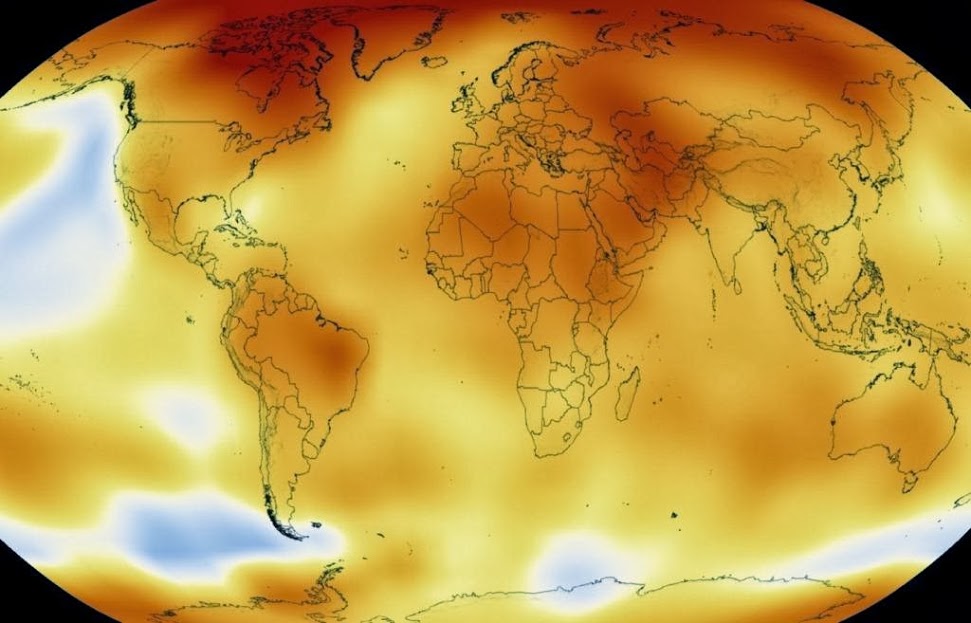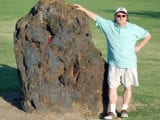Even though climate change is relatively new historically, journalists shouldn’t be treating it like Justin Bieber’s arrest. –

This visualization shows how global temperatures have risen from 1950 through the end of 2013/NASA/GSFC, GISS (See video below)
By Tom Engelhardt –
Here’s the scoop: When it comes to climate change, there is no “story,” not in the normal news sense anyway.
The fact that 97 percent of scientists who have weighed in on the issue believe that climate change is a human-caused phenomenon is not a story.
That only one of 9,137 peer-reviewed papers on climate change published between November 2012 and December 2013 rejected human causation is not a story either, nor is the fact that only 24 out of 13,950 such articles did so over 21 years. That the anything-but-extreme Intergovernmental Panel on Climate Change (IPCC) offers an at least 95 percent guarantee of human causation for global warming is not a story, nor is the recent revelation that IPCC experts believe we only have 15 years left to rein in carbon emissions or we’ll need new technologies not yet in existence which may never be effective.
Nor is the recent poll showing that only 47 percent of Americans believe climate change is human-caused (a drop of 7 percent since 2012) or that the percentage who believe climate change is occurring for any reason has also declined since 2012 from 70 percent to 63 percent. Nor is the fact that, as the effects of climate change came ever closer to home, media coverage of the subject dropped between 2010 and 2012 and, though rising in 2013, was still well below coverage levels for 2007 to 2009.
Nor is it a story that European nations, already light years ahead of the United States on phasing out fossil fuels, recently began considering cutbacks on some of their climate change goals, nor that US carbon emissions actually rose in 2013, nor that the southern part of the much disputed Keystone XL pipeline, which is to bring particularly carbon-dirty tar sands from Alberta, Canada, to the US Gulf Coast, is now in operation , nor that 2013 will have been either the fourth or seventh hottest year on record, depending on how you do the numbers.
Don’t misunderstand me. Each of the above was reported somewhere and climate change itself is an enormous story, if what you mean is Story with a capital S. It could even be considered the story of all stories. It’s just that climate change and its component parts are unlike every other story from the Syrian slaughter and the problems of Obamacare to Bridgegate and Justin Bieber’s arrest. The future of all other stories, of the news and storytelling itself, rests on just how climate change manifests itself over the coming decades or even century. What happens in the 2014 midterms or the 2016 presidential elections, in our wars, politics, and culture, who is celebrated and who ignored—none of it will matter if climate change devastates the planet.
Climate change isn’t the news and it isn’t a set of news stories. It’s the prospective end of all news. Think of it as the anti-news.
All the rest is part of the annals of human history: the rise and fall of empires, of movements, of dictatorships and democracies, of just about anything you want to mention. The most crucial stories, like the most faddish ones, are—every one of them—passing phenomena, which is of course what makes them the news.
Climate change isn’t. New as that human-caused phenomenon may be— having its origins in the industrial revolution—it’s nonetheless on a different scale from everything else, which is why journalists and environmentalists often have so much trouble figuring out how to write about it in a way that leaves it continually in the news. While no one who, for instance, lived through “Frankenstorm” Sandy on the East Coast in 2012 could call the experience “boring”—winds roaring through urban canyons like freight trains, lights going out across lower Manhattan, subway tunnels flooding, a great financial capital brought to its proverbial knees—in news terms, much of global warming is boring and repetitive. I mean, drip, drip, drip. How many times can you write about the melting Arctic sea ice or shrinking glaciers and call it news? How often are you likely to put that in your headlines?
We’re so used to the phrase “the news” that we often forget its essence: what’s “new” multiplied by that “s.” It’s true that the “new” can be repetitively so. How many times have you seen essentially the same story about Republicans and Democrats fighting on Capitol Hill? But the momentousness of climate change, which isn’t hard to discern, is difficult to regularly turn into meaningful “new” headlines (“Humanity Doomed If…”), to repeatedly and successfully translate into a form oriented to the present and the passing moment, to what happened yesterday, today, and possibly tomorrow.
If the carbon emissions from fossil fuels are allowed to continue to accumulate in the atmosphere, the science of what will happen sooner or later is relatively clear, even if its exact timetable remains in question: this world will be destabilized as will humanity (along with countless other species [20]). We could, at the worst, essentially burn ourselves off Planet Earth. This would prove a passing event for the planet itself, but not for us, nor for any fragment of humanity that managed to survive in some degraded form, nor for the civilizations we’ve developed over thousands of years.
In other words, unlike “the news,” climate change and its potential devastations exist on a time scale not congenial either to media time or to the individual lifetimes of our short-lived species. Great devastations and die-offs have happened [21] before. Give the planet a few million years and life of many sorts will regenerate and undoubtedly thrive. But possibly not us.
Nuclear Dress Rehearsal
Here’s the strange thing: we went through a dress rehearsal for this in the twentieth century when dealing (or not dealing) with nuclear weapons, aka the Bomb—often capitalized in my youth as a sign of how nuclear disaster was felt to be looming over life itself. With the dropping of that “victory weapon” on two Japanese cities in 1945, a new era opened. For the first time, we humans—initially in Washington, then in Moscow, then in other national capitals—took the power to end all life on this planet out of God’s hands. You could think of it as the single greatest, if also grimmest, act of secularization in history. From 1945 on, at least prospectively, we could do what only God had previously been imagined capable of: create an End Time on this planet.
In itself, that was a remarkable development. And there was nothing figurative about it. The US military was involved in what, in retrospect, can only be considered operational planning for world’s end. In its first “Single Integrated Operational Plan,” or SIOP, in 1960, for instance, it prepared to deliver more than 3,200 nuclear weapons to 1,060 targets in the Communist world, including at least 130 cities which would then, if all went well, cease to exist. Official estimates of casualties ran to 285 million dead and 40 million injured. (Those figures undoubtedly underestimated radiation and other effects, and today we also know that the exploding of so many nuclear weapons would have ended life as we know it on this planet.) In those years, in the most secret councils of government, American officials also began to prepare for the possibility that 100 Russian missiles might someday land on US targets, killing or injuring 22 million Americans. Not so many years later, the weaponry of either of the superpowers had the capability of destroying the planet many times over.
The US and the USSR were by then locked in a struggle that gained a remarkably appropriate acronym: MAD (for “mutually assured destruction”). During the Cold War, the US built [25] an estimated 70,000 nuclear warheads and bombs of every size and shape, the Soviet Union 55,000, and with them went a complex semi-secret nuclear geography of missile silos, plutonium plants, and the like that shadowed the everyday landscape we knew.
In 1980, scientists discovered a layer of particularly iridium-rich clay in sediments 65 million years old, evidence that a vast asteroid impact had put such a cloud of particulates into the atmosphere as to deprive the planet of sunshine, turning it into a wintry vista, and in the process contributing to the demise of the dinosaurs. In the years that followed, it became ever clearer that nuclear weapons, dispatched in the quantities both the US and USSR had been planning for, would have a similar effect. This prospective phenomenon was dubbed “nuclear winter.”
In this way, nuclear extermination would also prove to be an apocalyptic weather event, giving it an affinity with what, in the decades to come, would be called “global warming” and then “climate change.” The nuclear story, the first (and at the time the only imaginable) tale of our extinction by our own hands, rose into the news periodically and even into front-page headlines, as during the Cuban Missile Crisis, as well as into the movies and popular culture. Unlike climate change, it was a global catastrophe that could happen at any moment and be carried to its disastrous conclusion in a relatively short period of time, bringing it closer to the today and tomorrow of the news.
Nonetheless, nuclear arsenals, too, were potential life-enders and so news-enders. As a result, most of the time their existence and development managed to translate poorly into daily headlines. For so many of those years in that now long-gone world of the Cold War stand-off, the nuclear issue was somehow everywhere, a kind of exterminationist grid over life itself, and yet, like climate change, nowhere at all. Except for a few brief stretches in those decades, antinuclear activists struggled desperately to bring the nuclear issue out of the shadows.
The main arsenals on the planet, still enormous, are now in a kind of nuclear hibernation [31] and are only “news” when, for instance, their very backwater status becomes an issue. This was the case recently with a spate of headlines about test cheating [32] and drug use scandals involving US Air Force “missileers” who feel that in their present posts they are career losers. Most of the major national arsenals are almost never mentioned in the news. They are essentially no-news zones. These would include the gigantic Russian one [34], the perhaps 200 weapons in the Israeli arsenal, and those of the British, French, Indians, and Pakistanis (except when it comes to stories about fears of future loose nukes from that country’s stock of weapons).
The only exceptions in the twenty-first century have been Iran, a country in the spotlight for a decade, even though its nuclear program lies somewhere between prospective and imaginary, and North Korea, which continues to develop a modest (but dangerous) arsenal. On the other hand, even though a full-scale nuclear war between Pakistan and India, each of which may now have about 100 weapons in their expanding arsenals, would be a global catastrophe [28] with nuclear-winter effects that would engulf the planet causing widespread famine , most of the time you simply wouldn’t know it. These days, it turns out we have other problems.
The End of History?
If the end of the world doesn’t fit well with “the news,” neither does denial. The idea of a futureless humanity is difficult to take in and that has undoubtedly played a role in suppressing the newsiness of both the nuclear situation and climate change. Each is now woven into our lives in essential, if little acknowledged, ways and yet both remain remarkably recessive. Add to that a fatalistic feeling among many that these are issues beyond our capacity to deal with, and you have a potent brew not just for the repression of news but also for the failure to weave what news we do get into a larger picture that we could keep before us as we live our lives. Who, after all, wants to live life like that?
And yet nuclear weapons and climate change are human creations, which means that the problems they represent have human solutions. They are quite literally in our hands. In the case of climate change, we can even point to an example of what can be done about a human-caused global environmental disaster-in-the-making: the “hole” in the ozone layer over Antarctica. Discovered in 1985, it continued to grow for years threatening a prospective health catastrophe. It was found to be due to the effects of CFC (chlorofluorocarbon) compounds used in air-conditioning units, refrigerators, and aerosol propellants, and then released into the atmosphere. In fact, the nations of the world did come together around CFCs, most of which have now been replaced, while that hole has been reduced, though it isn’t expected to heal entirely until much later this century.
Of course, compared with the burning of fossil fuels, the economic and political interests involved in CFCs were minor. Still, the Montreal Protocol [41] on Substances That Deplete the Ozone Layer is evidence that solutions can be reached, however imperfectly, on a global scale when it comes to human-caused environmental problems.
What makes climate change so challenging is that the carbon dioxide (and methane ) being generated by the extraction, production, and burning of fossil fuels supports the most profitable corporations in history, as well as energy states like Saudi Arabia and Russia that are, in essence, national versions of such corporations. The drive for profits has so far proven unstoppable. Those who run the big oil companies, like the tobacco companies before them, undoubtedly know what potential harm they are doing to us. They know what it will mean for humanity if resources (and profits) aren’t poured into alternative energy research and development. And like those cigarette companies, they go right on. They are indeed intent, for instance, on turning North America into “Saudi America,” and hunting down and extracting the last major reserves of fossil fuel in the most difficult spots on the planet. Their response to climate change has, in fact, been to put some of their vast profits into the funding of a campaign of climate-change denialism (and obfuscation) and into the coffers of chosen politicians and think tanks willing to lend a hand.
In fact, one of the grim wonders of climate change has been the ability of Big Energy and its lobbyists to politicize an issue that wouldn’t normally have a “left” or “right,” and to make bad science into an ongoing news story. In other words, an achievement that couldn’t be more criminal in nature has also been their great coup de théâtre.
In a world heading toward the brink, here’s the strange thing: most of the time that brink is nowhere in sight. And how can you get people together to solve a human-caused problem when it’s so seldom meaningfully in the news (and so regularly challenged by energy interests when it is)?
This is the road to hell and it has not been paved with good intentions. If we stay on it, we won’t even be able to say that future historians considered us both a wonder (for our ability to create world-ending scenarios and put them into effect) and a disgrace (for our inability to face what we had done). By then, humanity might have arrived at the end of history, and so of historians.
Tom Engelhardt, a co-founder of the American Empire Project and author of The United States of Fear as well as a history of the Cold War, The End of Victory Culture, runs the Nation Institute’s TomDispatch.com. His latest book, co-authored with Nick Turse, is Terminator Planet: The First History of Drone Warfare, 2001-2050.
[Note: I would like to thank Jonathan Schell for loaning me the term “anti-news” in relation to climate change.]Check out the newest Dispatch Book, Ann Jones’s They Were Soldiers: How the Wounded Return From America’s Wars—The Untold Story.
Re-published with permission from TomDispatch: Climate Change as the Anti-News













